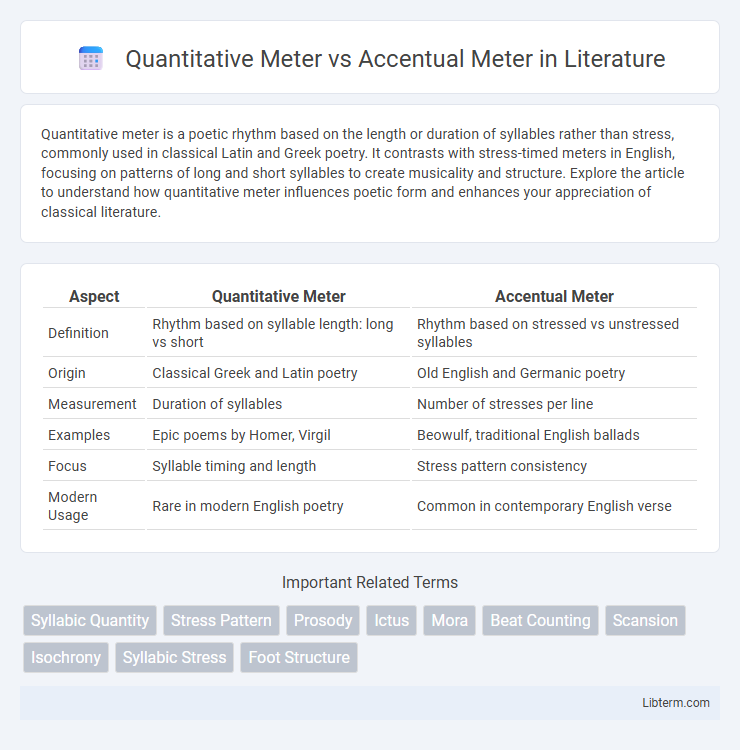Quantitative meter is a poetic rhythm based on the length or duration of syllables rather than stress, commonly used in classical Latin and Greek poetry. It contrasts with stress-timed meters in English, focusing on patterns of long and short syllables to create musicality and structure. Explore the article to understand how quantitative meter influences poetic form and enhances your appreciation of classical literature.
Table of Comparison
| Aspect | Quantitative Meter | Accentual Meter |
|---|---|---|
| Definition | Rhythm based on syllable length: long vs short | Rhythm based on stressed vs unstressed syllables |
| Origin | Classical Greek and Latin poetry | Old English and Germanic poetry |
| Measurement | Duration of syllables | Number of stresses per line |
| Examples | Epic poems by Homer, Virgil | Beowulf, traditional English ballads |
| Focus | Syllable timing and length | Stress pattern consistency |
| Modern Usage | Rare in modern English poetry | Common in contemporary English verse |
Introduction to Poetic Meter
Quantitative meter in poetry measures the duration of syllables, distinguishing between long and short sounds, rooted in classical Latin and Greek traditions. Accentual meter bases rhythm on stressed syllables regardless of syllable length, commonly found in English poetry and Old English verse. Understanding these foundational metrical patterns enhances appreciation of poetic rhythm and form across different linguistic and cultural contexts.
Defining Quantitative Meter
Quantitative meter is a poetic rhythm determined by the length of time taken to pronounce syllables, focusing on patterns of long and short syllables rather than stress. This system, prevalent in classical Latin and Greek poetry, contrasts with accentual meter, which organizes verses around stressed and unstressed syllables. Understanding quantitative meter is essential for analyzing ancient verse structures and their rhythmic properties.
Understanding Accentual Meter
Accentual meter emphasizes the pattern of stressed syllables in a line of poetry, relying on the number of accents rather than syllable count. This meter allows for variations in unstressed syllables, creating rhythmic flexibility and a natural speech-like flow. Understanding accentual meter involves recognizing its stress-based structure, commonly found in Old English and Anglo-Saxon poetry, contrasting with the fixed syllable patterns of quantitative meter.
Historical Origins and Development
Quantitative meter, rooted in ancient Greek and Latin poetry, relies on the length of syllables, distinguishing between long and short durations to create rhythmic patterns. Accentual meter, prominent in Old English and Germanic traditions, emphasizes stressed syllables rather than syllable length, shaping cadence through emphasis and stress. The divergence in these metrical systems reflects broader linguistic shifts from classical languages with fixed syllable quantities to vernacular tongues prioritizing stress and accentuation.
Key Differences Between Quantitative and Accentual Meter
Quantitative meter is based on the duration of syllables, distinguishing between long and short sounds to create rhythmic patterns, while accentual meter depends on the stress or emphasis placed on syllables regardless of their length. In quantitative meter, units called morae measure time, commonly found in classical Latin and Greek poetry, whereas accentual meter relies on stressed beats per line, typical in English and Germanic verse. The key difference lies in how rhythm is structured: quantitative meter prioritizes syllable length, whereas accentual meter focuses on the pattern of stressed syllables.
Examples of Quantitative Meter in Literature
Quantitative meter, which measures syllable length, is prominently featured in classical Latin and Ancient Greek poetry such as Virgil's "Aeneid" and Homer's "Iliad," where patterns of long and short syllables define rhythmic structure. Accentual meter, contrastingly, relies on stress patterns evident in Old English poetry like "Beowulf," emphasizing a fixed number of stressed syllables per line regardless of syllable length. The dominance of quantitative meter in ancient literature illustrates the integral role of syllable duration in shaping poetic versification traditions across cultures.
Examples of Accentual Meter in Poetry
Accentual meter emphasizes the number of stressed syllables per line regardless of total syllables, exemplified in traditional Old English poetry like "Beowulf," where each line contains four stressed syllables with varying unstressed beats. Another example is the nursery rhyme "Mary, Mary, quite contrary," which follows an accentual pattern focused on stress rather than syllable count. Accentual meter contrasts with quantitative meter, which is based on syllable length, as seen in classical Latin and Greek poetry.
Influence on Language and Culture
Quantitative meter, based on syllable length, profoundly influenced classical languages such as Latin and Ancient Greek, shaping poetic forms and oral traditions in these cultures. Accentual meter, relying on stress patterns, predominates in English and Germanic languages, reflecting natural speech rhythms and facilitating oral storytelling and song. These metrical systems affect literary aesthetics and cultural identity by aligning closely with the phonological characteristics of their respective languages.
Applications in Modern Poetry
Quantitative meter, based on syllable length, is less common in modern English poetry due to its reliance on vowel duration measurements, which are challenging to maintain naturally in non-classical languages. Accentual meter, focusing on stressed syllables rather than syllable quantity, aligns more effectively with the rhythmic patterns of contemporary English, making it predominant in modern verse forms like free verse and blank verse. Poets leverage accentual meter for its flexibility in conveying emotion and natural speech rhythms, optimizing reader engagement and interpretive depth.
Conclusion: Choosing the Right Meter
Selecting the appropriate meter between quantitative and accentual depends on the language's phonetic structure and the poem's rhythmic goals. Quantitative meter, based on syllable length, suits classical languages like Latin and Greek, while accentual meter, relying on stressed syllables, fits most modern English poetry. Understanding the linguistic and cultural context ensures an effective and harmonious poetic composition.
Quantitative Meter Infographic

 libterm.com
libterm.com